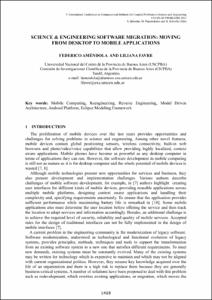Mostra el registre d'ítem simple
Science & engineering software migration: moving from desktop to mobile applications
| dc.contributor.author | Améndola, Federico |
| dc.contributor.author | Favre, Liliana |
| dc.date.accessioned | 2020-07-10T16:59:58Z |
| dc.date.available | 2020-07-10T16:59:58Z |
| dc.date.issued | 2013 |
| dc.identifier.isbn | 978-84-941407-6-1 |
| dc.identifier.uri | http://hdl.handle.net/2117/192858 |
| dc.description.abstract | The proliferation of mobile devices over the last years provides opportunities and challenges for solving problems in science and engineering. Among other novel features, mobile devices contain global positioning sensors, wireless connectivity, built-in web browsers and photo/video/voice capabilities that allow providing highly localized, context aware applications. Mobile phones have become as powerful as any desktop computer in terms of applications they can run. However, the software development in mobile computing is still not as mature as it is for desktop computer and the whole potential of mobile devices is wasted [7, 8]. |
| dc.format.extent | 12 p. |
| dc.language.iso | eng |
| dc.publisher | CIMNE |
| dc.subject | Àrees temàtiques de la UPC::Matemàtiques i estadística::Anàlisi numèrica::Mètodes en elements finits |
| dc.subject.lcsh | Finite element method |
| dc.subject.lcsh | Coupled problems (Complex systems) -- Numerical solutions |
| dc.subject.other | Mobile Computing, Reengineering, Reverse Engineering, Model Driven Architecture, Android Platform, Eclipse Modeling Framework |
| dc.title | Science & engineering software migration: moving from desktop to mobile applications |
| dc.type | Conference report |
| dc.subject.lemac | Elements finits, Mètode dels |
| dc.rights.access | Open Access |
| local.citation.contributor | COUPLED V |
| local.citation.publicationName | COUPLED V : proceedings of the V International Conference on Computational Methods for Coupled Problems in Science and Engineering : |
| local.citation.startingPage | 1418 |
| local.citation.endingPage | 1429 |
Fitxers d'aquest items
Aquest ítem apareix a les col·leccions següents
-
V International Conference on Computational Methods for Coupled Problems in Science and Engineering (COUPLED 2013) Santa Eulàlia, Ibiza, Spain, 17-19 June, 2013 [134]
A conference celebrating the 60th birthday of Eugenio Oñate


